___________________________________________________________________
Research on floating Raceways for Nursery
Production of Largemouth Bass (Phase I)

Sandhya Lamichhane’s research will document food availability, and selectivity of phase I largemouth bass in nursery ponds and raceways with a managed bloom. A bloom in ponds refers to an excessive growth of algae or other microscopic organisms, such as phytoplankton, that can cause the water to appear green, brown, or red. These blooms are often visible on the surface as a dense layer or scum. Sandhya will compare zooplankton abundance in managed nursery ponds and stomach contents of phase I LMB in both ponds and floating raceways.
Blooms are important as they can have both positive and negative impacts on the ecosystem. On one hand, they play a vital role in the food chain as a primary food source for various aquatic organisms and help maintain the overall biodiversity of the pond. Additionally, they contribute to oxygen production through photosynthesis.
However, excessive blooms can also have negative consequences. When the bloom is too dense, it can block sunlight from reaching deeper layers of water, impacting the growth of underwater plants and disrupting the habitat for fish and other organisms. As these blooms eventually die off, decomposition by bacteria can deplete oxygen levels in the water, leading to a phenomenon known as hypoxia or dead zones, which can be harmful
to aquatic life.
Andrew Stephan’s will compare open pond culture and a floating raceway system for nursery production of phase I largemouth bass in ponds with managed blooms. A secondary task Andrew will compare these results with floating raceways in a naturally fertile (fed) pond with an unmanaged bloom.
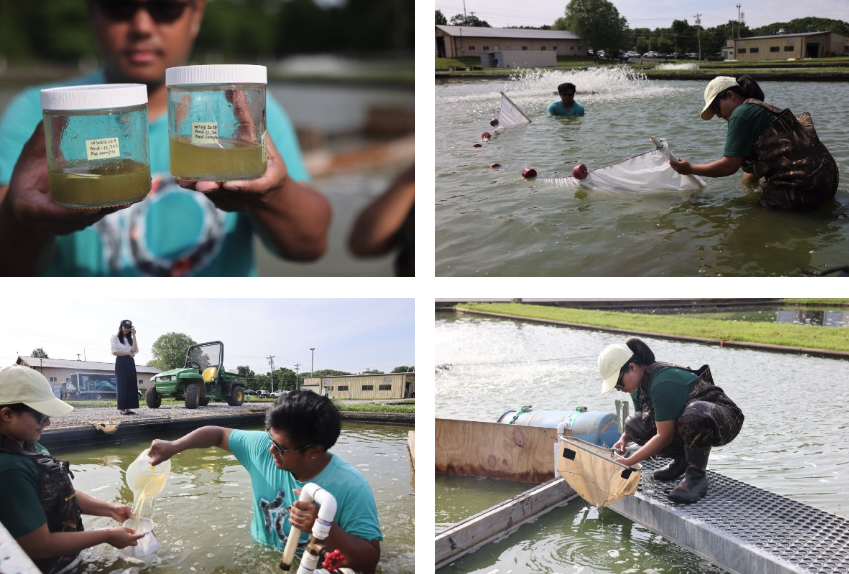
Photos by Charles Weibel
___________________________________________________________________
Dr. Andrew Ray Presents at Shrimp Summit

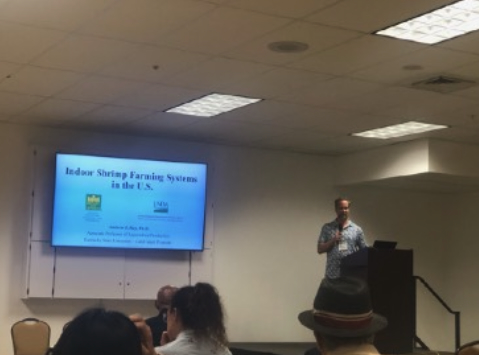
Dr. Ray traveled to the inaugural Florida Shrimp Summit in Fort Pierce, Florida. He gave a presentation titled "Indoor Shrimp Farming Systems in the U.S." which covered several different strategies and technologies that can be used to successfully grow shrimp indoors. Some of the information was gathered from a comprehensive survey of U.S. shrimp farms that Dr. Ray conducted, other information he had gathered by visiting farms across the world and conducting state- of-the-art research right here at KSU. There were about 50 people in the audience and they had a very positive reaction to Dr. Ray's presentation. This is another example of the many ways that KSU Aquaculture is reaching a broad set of constituents to deliver impactful information that helps drive the aquaculture industry forward.
__________________________________________________________________________________
Sagun Samples Flounder Research Project
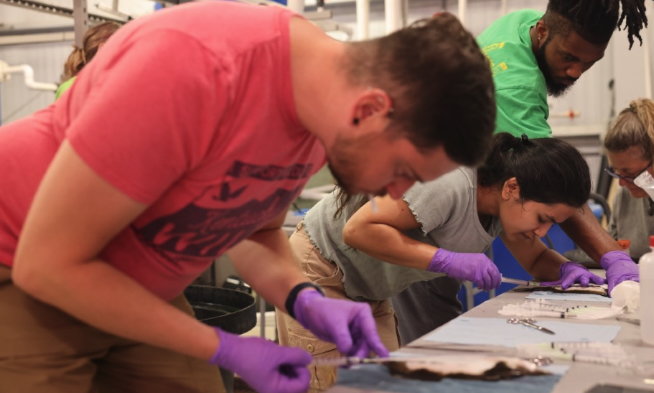
Ms. Sagun Chhetri conducted a sample of her research project with the assistance of Dr. Ray and his crew, focusing on the growth of flounder under varying stocking densities. The results may indicate that flounder exhibit superior growth in low stocking density conditions, with a current average weight exceeding 300 grams, followed by medium and high densities. Overall, the survival rate has been satisfactory, with minimal instances of mortalities observed thus far. The projected completion date for Ms. Chhetri's research is approximately in the middle of June 2024. At harvest, Sagun will obtain her last sample to evaluate fish growth and extract blood samples for analysis. Regarding the extraction of DNA from fin clips, the objective is to examine whether genes associated with stress exhibit greater expression in fish reared under high stocking density compared to those in low density tanks.
It is important to note that the specific genes and stress-related pathways in fish can vary depending on the species and the particular stressor applied. For example, Cortisol, a hormone involved in the fish stress response, plays a significant role. Genes responsible for cortisol synthesis, such as the steroidogenic acute regulatory protein (StAR), cytochrome P450 11B (CYP11B), and 11-beta-hydroxylase (CYP11B1), are associated with the fish's ability to regulate stress. Furthermore, it is crucial to consider that the expression of these genes can be influenced by factors such as the specific stressor, duration and intensity of the stress, as well as inherent variations among fish species. Researchers conduct comprehensive studies to identify and comprehend the specific genes and pathways implicated in stress responses among different fish species, aiming to gain insights into their adaptive capabilities and responses to environmental stressors.
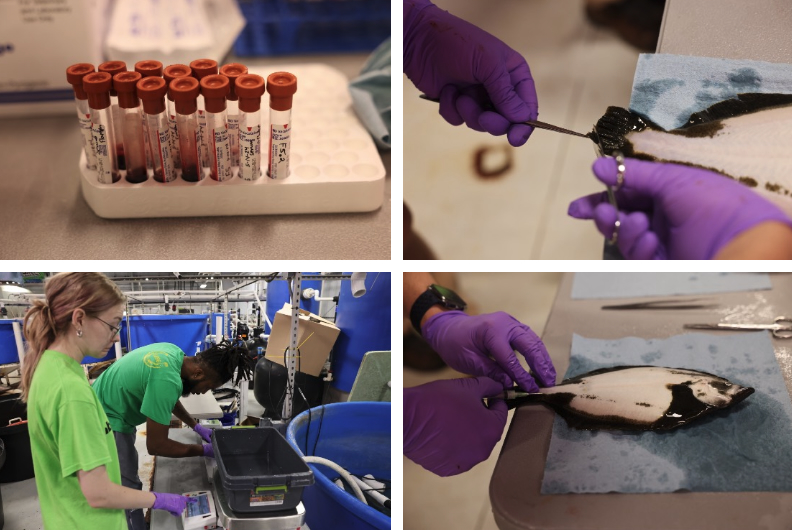
Photos by Charles Weibel
_________________________________________________________________________________
Aquaculture Students Bring Home Awards From
Aquaculture America Conference
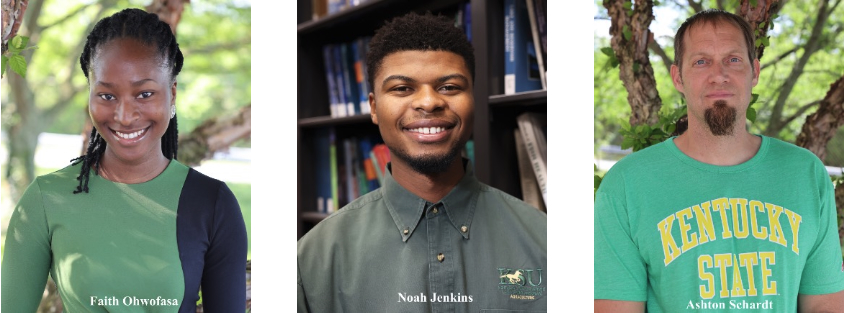
Kentucky State University is proud to announce the outstanding achievements of its aquaculture graduate students at the prestigious Aquaculture America conference and exposition, held in San Antonio, Texas in February 2024. This highly regarded national event provides a platform for students to showcase their research projects and compete among peers and experts in the field. With the opportunity to submit abstracts for consideration, Kentucky State University sent a group of exceptional students to participate in oral and poster presentations at this esteemed gathering. This experience enabled them to demonstrate their knowledge in the STEM areas and aquaculture, while answering insightful questions from industry professionals and experts. The conference not only provided the students with a chance to present their research in a professional setting but also exposed them to cutting-edge aquaculture research and industry advancements shared by esteemed professionals. Additionally, the event fostered valuable networking opportunities among like-minded peers and industry leaders.
We are thrilled to share with you the impressive accomplishments of our students, who truly rose to the occasion and brought home remarkable accolades for Kentucky State University. Noah Jenkins secured a commendable Second Place for his outstanding oral presentation, while Faith Ohwofasa dazzled the judges with a striking second- place win for her poster presentation. Ashton Schardt's remarkable oral presentation earned him a well- deserved third-place recognition. Their hard work and dedication have paid off, and their achievements will be published in the esteemed Aquaculture Magazine. These triumphs not only reflect the exceptional talent and commitment of our students but also bring great recognition to Kentucky State University's Aquaculture Program, College of Agriculture, and our institution as a whole.
We are immensely proud of their accomplishments and their representation of our university on a national stage. We extend our sincere congratulations to Noah Jenkins, Faith Ohwofasa, Ashton Schardt, and all the students who participated in the conference. Their success underscores the exceptional educational opportunities and support provided by Kentucky State University.
Photos by Charles Weibel
___________________________________________________________________
Dole Daleiden Defends His Thesis
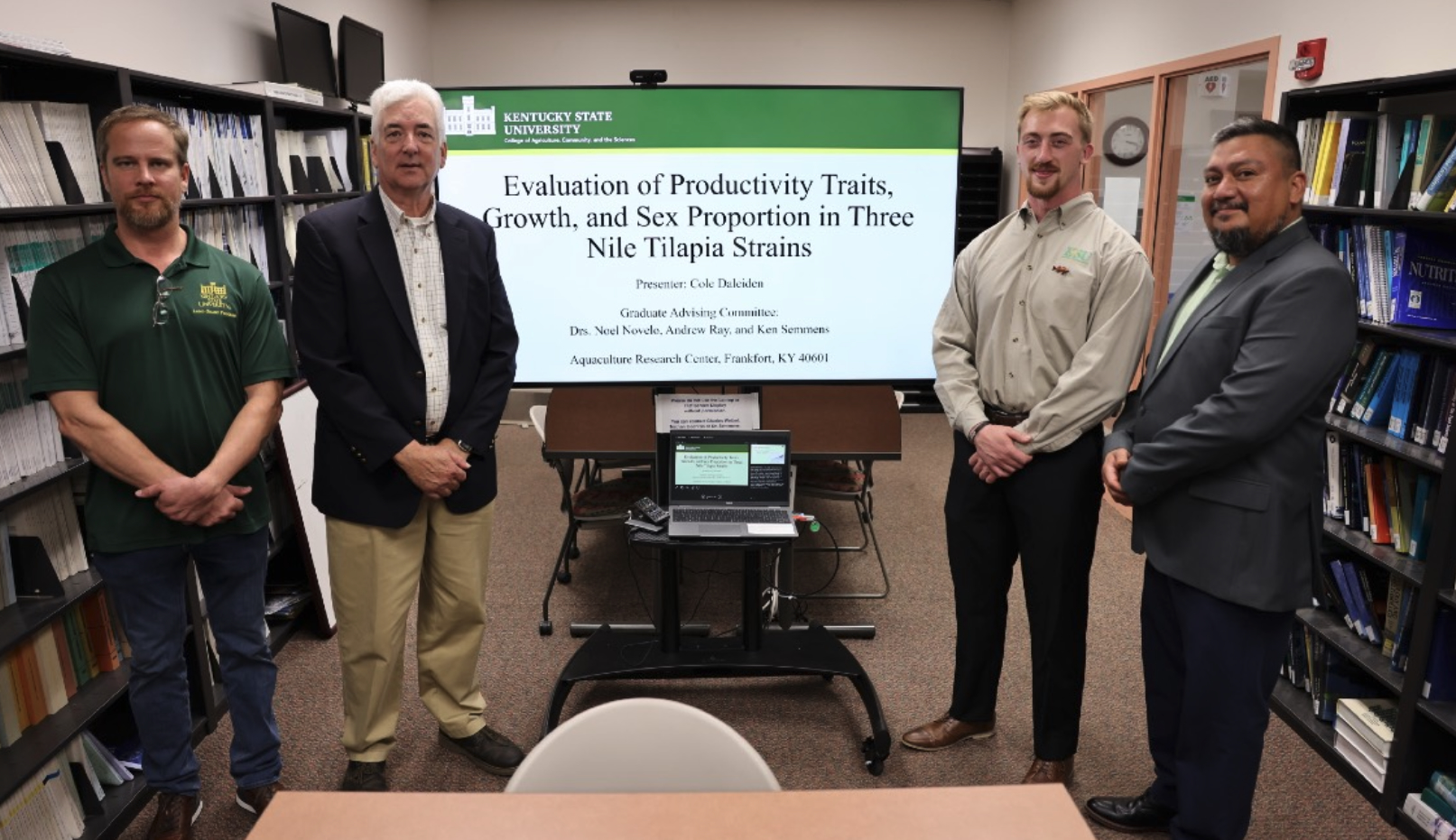
We are thrilled to share the exciting news of Cole's successful thesis defense at the Kentucky State University Aquaculture Research Center! With his presentation titled "Evaluation of Productivity Traits, Growth, and Sex Proportion in Three Strains of Nile Tilapia," Cole showcased his expertise and dedication to his research. The atmosphere during the presentation was delightful, with pizza, an ice cream bar, and other tasty snacks provided to keep the audience satisfied and engaged. Despite the demands of a long Friday afternoon, Cole's hard work and preparation paid off, making him the newest graduate student to successfully defend his thesis. We extend our warmest congratulations to Cole on this significant milestone in his academic journey. None of this would have been possible without the guidance and support of his advising professor, Dr. Noel Novelo, who played a crucial role in shaping Cole's research and guiding him toward success. Cole's achievement is a testament to his commitment, perseverance, and intellectual prowess. Once again, congratulations, Cole! Your accomplishment is well-deserved, and we wish you continued success in all your future endeavors.
Photo by Charles Weibel
__________________________________________________________________________________
Ashton Schardt Selected as Graduate Student of the Year

We are delighted to announce that Ashton Schardt has been selected as the recipient of the 2024 Outstanding Graduate Student of the Year Award. This prestigious accolade is determined annually by the Aquaculture Faculty, with input from various factors such as academics and leadership. Under the guidance and mentorship of Dr. Rossi from the Aquaculture Research Center Nutrition Lab, Ashton has displayed exemplary dedication and commitment to his studies. His impressive academic achievements and passion for the field of aquaculture have set him apart as a deserving candidate for this recognition. Furthermore, Ashton's active involvement in the AQUACULTURE AMERICA Student Sub Unit and his participation in other student activities have showcased his exemplary leadership skills and commitment to contributing to the academic community. His thoughtful attention to detail and diligent work ethic have greatly enriched the programs and initiatives at KSU and the Aquaculture Research Center. We extend our warmest congratulations to Ashton Schardt for this well-deserved honor and commend him for his outstanding contributions to the field of aquaculture.
Photo by Charles Weibel
__________________________________________________________________________________
Dr. Ray Visit Largest Indoor Shrimp Farm
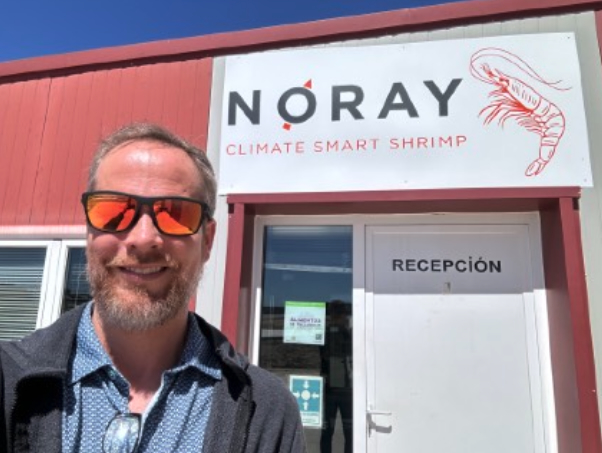
Dr. Andrew Ray recently had the opportunity to visit the largest indoor shrimp farm in Europe to evaluate their technology and provide recommendations for potential improvements. Located near Madrid, Spain, this farm has been operating for over 15 years, is currently undergoing expansion, and relies heavily on solar energy for power. While pictures from inside the farm cannot be shared due to trade secrets, the farm constantly strives to enhance sustainability, product quality, and production levels through continuous innovation. This collaboration allows Dr. Ray to contribute to the growth of the global industry while benefiting from the groundbreaking research conducted at Kentucky State University.
Europe ranks as the third-largest market for Pacific white shrimp worldwide, following the United States and China. In 2019, Europe imported an estimated EUR 1.9 billion worth of Pacific white shrimp. The volume of Pacific white shrimp imports in Europe for 2019 reached approximately 370,000 tonnes, a 7.5% decrease compared to 2018. Key European importers include France, Spain, the United Kingdom, Italy, the Netherlands, Germany, and Belgium, which collectively account for around 80% of the total European Pacific white shrimp imports.
In the United States, shrimp consumption has been steadily increasing since 2013, reaching a peak of 5.9 pounds per person in 2021. As of 2023, the US shrimp market size has reached 953,200 tons. Shrimp consumption represents 38% of the annual seafood consumption in the US, surpassing combined consumption of canned tuna, tilapia, Alaska pollock, pangasius, cod, and crab.

___________________________________________________________________
Three Kentucky State University Aquaculture Students Graduate Earn Their Masters
in Aquaculture and Aquatic Sciences
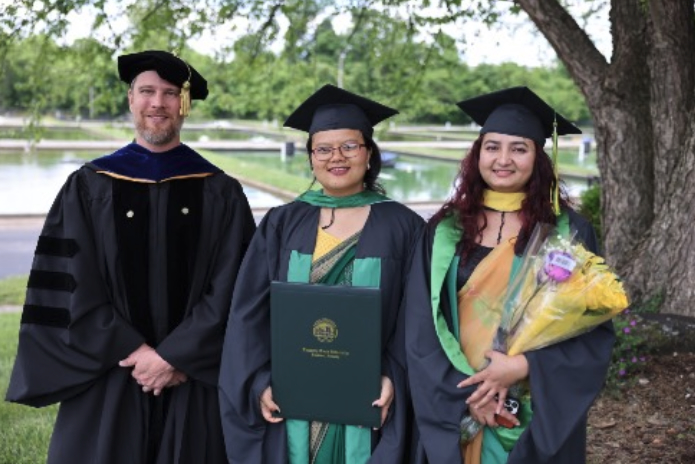
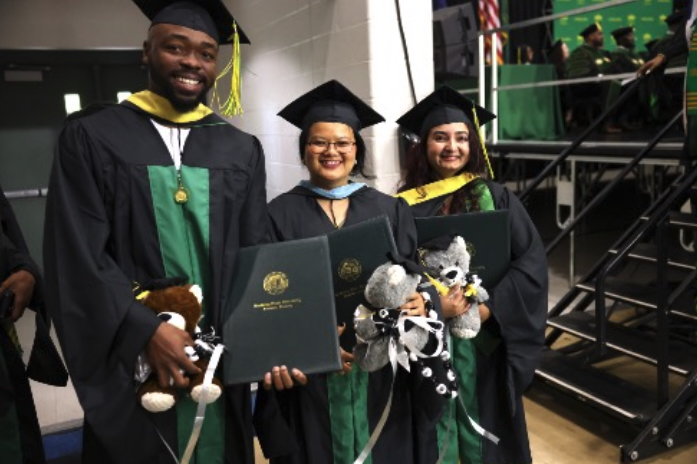
We are delighted to share the remarkable achievements of three outstanding aquaculture graduate students from Kentucky State University. Uchechukwu Ohajiudu, Gaynu Rana, and Aakriti Khanal proudly received their well-deserved diplomas at the 2024 Kentucky State University Commencement ceremony.
Having successfully completed all course requirements and other necessary qualifications, Uchechukwu,
Gaynu, and Aakriti made a conscious decision to return to their alma mater to personally accept their diplomas. This symbolic gesture speaks volumes about their deep sense of pride and connection to
Kentucky State University. With their bright futures ahead, Uchechukwu and Aakriti have chosen to continue their educational pursuits by embarking on Ph.D. programs, further expanding their knowledge and expertise in the field of aquaculture. Meanwhile, Gaynu is currently engaged in searching for employment, aiming to contribute to the industry with the skills acquired during her studies. As we celebrate the accomplishments of these remarkable individuals, we are reminded of the profound impact that graduate students have on society. They are comparable to stars that have completed their constellations, illuminating the sky with the knowledge and wisdom gained from their dedicated efforts. Their unwavering determination, resilience, and relentless pursuit of excellence serve as an inspiration for future generations and leave an enduring legacy.
We extend our heartfelt congratulations not only to Uchechukwu, Gaynu, and Aakriti but also to all the remarkable graduates of 2024. Their achievements are a testament to their hard work, dedication, and commitment to personal and academic growth.

Photos by Charles Weibel
_________________________________________________________________________________
The USAS Aquaculture Subunit Volunteer at the Legislator Fish Fry
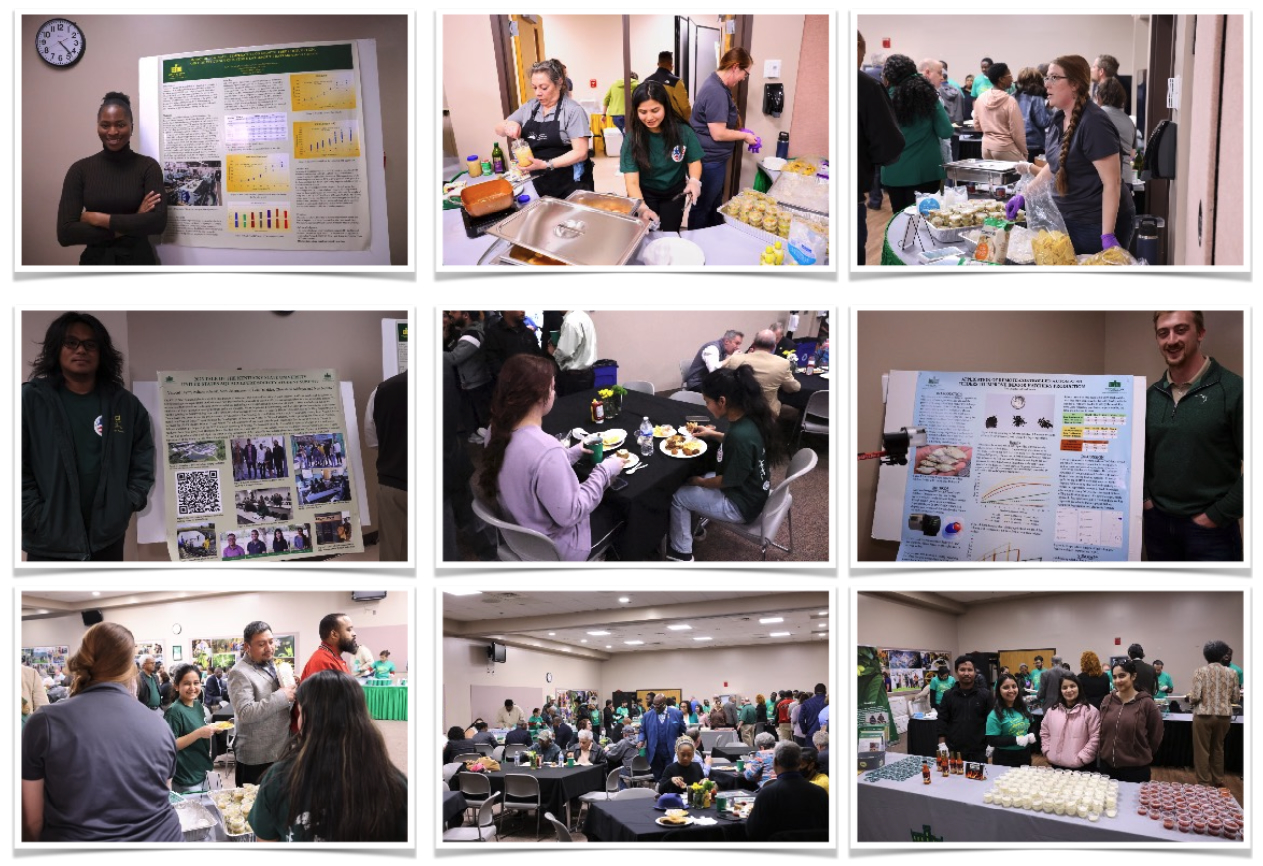
The Aquaculture Subunit volunteers made a valuable contribution at the Legislator Fish Fry. Not only did Aquaculture students assist in preparing and serving food, but they also had the chance to network with others. Moreover, they proudly showcased their research posters, highlighting their important work. To top it all off, they enjoyed a delightful fish dinner, creating a memorable experience. We deeply appreciate their support in making this annual event a success.
Photos by Charles Weibel
___________________________________________________________________
Sagun Stocks Olive Flounder into Recirculating Aquaculture Systems
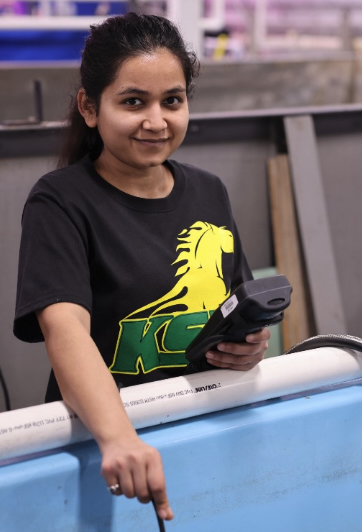
The olive flounder (Paralichthys olivaceus) is a flatfish species that has been practically domesticated in Asia and is an excellent candidate for production in recirculating aquaculture systems (RAS). The fish has a very high market price, the meat is sashimi-grade, it grows quickly, and has a low feed conversion rate (FCR). To help optimize the production of this species in RAS, Sagun is conducting an experiment to evaluate the effects of stocking density on production metrics and stress-indicating compounds.
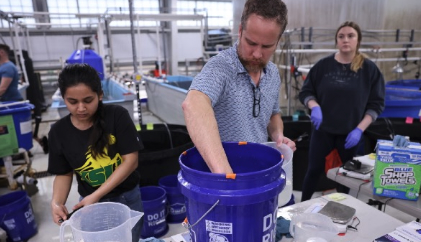
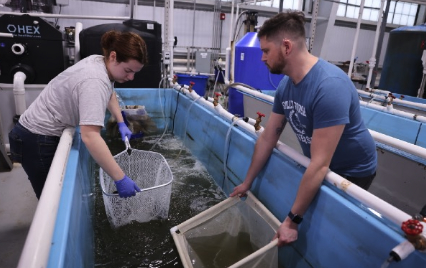
The Ray Lab has just finished constructing a state-of-the-art RAS which includes nine 1.2 m2 tanks.
Sagun and the team received approximately 2,000 fish from the University of Miami and raised them in nursery tanks for about three months. They then stocked the new tanks at three different commercial-level densities: 2.7, 5.4, and 8.1 kg/m2 to make the three treatments which include three replicate tanks each. Sagun will be measuring growth, biomass, survival, FCR, as well as comparative levels of cortisol, glucose, growth hormone, and insulin-like growth factor-1 in the fish blood. This work will be used to help determine the suitability of olive flounder in RAS so that domestic farmers may have new and valuable fish species to help expand U.S.
aquaculture.
Photos by Charles Weibel
___________________________________________________________________
Ray Lab New Publication
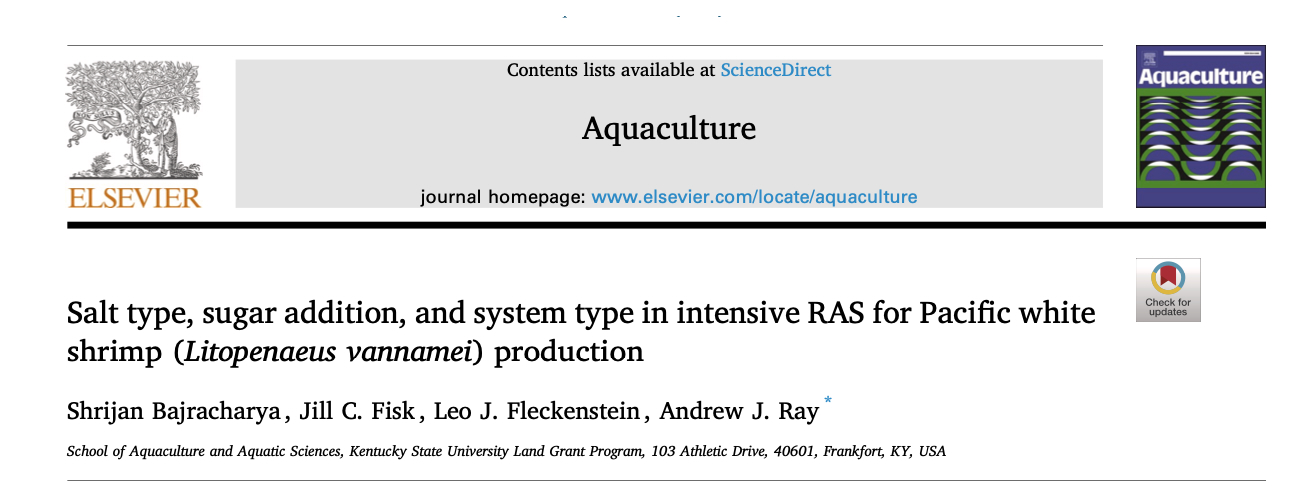
The Ray Lab published a new manuscript in the prestigious journal Aquaculture. The paper is the result of Shrijan Bajracharya’s thesis research here at KSU with marine shrimp. It details an experiment that examined the effects of an in-house made sea salt compared to a commercial salt, the effects of clear-water culture systems versus more turbid systems, and the addition of sugar as a bacterial carbon source versus no extra carbon addition.
The results are somewhat nuanced, but in general, indicate that the combination of more turbid systems (with less filtration), no sugar addition, and the in-house made salt mix (which is half the cost of commercial salt) had the best results. Indications of success include improved animal growth rates, and optimal water quality in that treatment. These results are currently being used to help bring down production costs in the growing U.S. inland marine shrimp farming industry. There are currently six marine shrimp farms in Kentucky alone, each of which has expanded production, or intends to soon, to keep up with demand for high quality, fresh,
sustainably grown shrimp.
Click Here For Full Journal Article
___________________________________________________________________
Proud Moment for Kentucky State University!
Our incredible faculty, staff, and students recently had the opportunity to shine at
Aquaculture America.

The third week of February, in sunny San Antonio, TX, our team left a lasting impression with their exceptional oral and poster presentations. The dedication and hard work of our students, faculty, and staff truly made our university stand out! Not only did our undergraduate and graduate students gain valuable knowledge from the event, but they also had a blast networking and attending socials with like-minded individuals. Making connections and forging new friendships in the aquaculture field is what it's all about!

Let's not forget the massive Aquaculture Trade Fair, boasting hundreds of booths showcasing the latest and greatest in the aquaculture industry. Our team had the chance to explore these exhibits, immersing themselves in the cutting-edge advancements of this rapidly evolving field.
What an incredible opportunity it was for our students to witness a wide range of presentations at Aquaculture America! From experts in the industry to students from various universities, this event provided valuable insight into the latest research and advancements in the field of aquaculture. Our students had the privilege to observe and learn from the best, gaining inspiration and expanding their knowledge base.
By witnessing the diverse research conducted by their peers, our students were exposed to different perspectives and innovative ideas. This exposure will undoubtedly contribute to their own growth as they continue their studies and research in the exciting world of aquaculture. Kentucky State University should take pride in the accomplishments of our faculty, staff, and students. They are the driving force behind our success, and their representation at Aquaculture America did us proud. Congratulations to everyone involved!
Photos by Charles Weibel
___________________________________________________________________
What a Successful Career Fair it was, Thanks to the Incredible Support of the USAS Student Subunit

Kentucky State University graduating seniors had access to valuable information about our programs and career opportunities. The Student USAS Subchapter played a pivotal role in guiding these seniors towards a bright future.
During the event, we had the pleasure of engaging in one-on-one conversations with approximately 10-15 students. Their interest in our programs was genuine, and they discovered new possibilities here at KSU.
Interestingly, not a single one of these students had even heard of our aquaculture programs before the Career Fair. They were pleasantly shocked to realize that such incredible opportunities were right here on campus. This realization highlights the importance of introducing our programs to incoming freshmen. We must bridge this information gap and ensure that every student is aware of the fantastic academic journey that awaits them at Kentucky State University’s Land Grant Program and the Aquaculture Research Center. As we move forward, it is imperative to focus on spreading the word about our exceptional programs, ensuring that every new freshman is informed and empowered to make the most of their time at KSU.

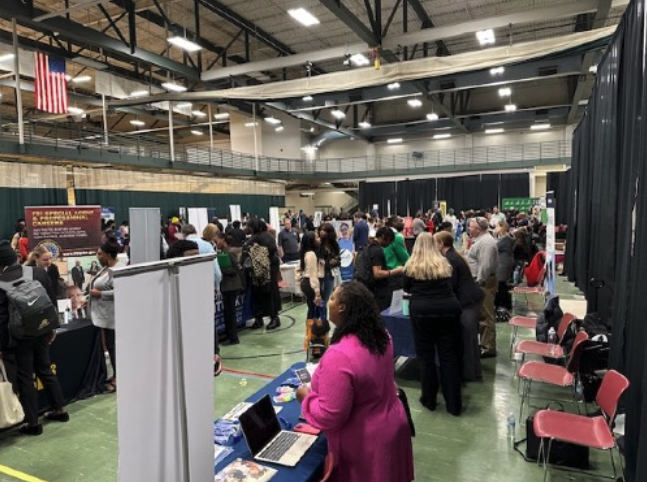
___________________________________________________________________
Tates Creek Middle School Visits the Kentucky State University Aquaculture Research Center
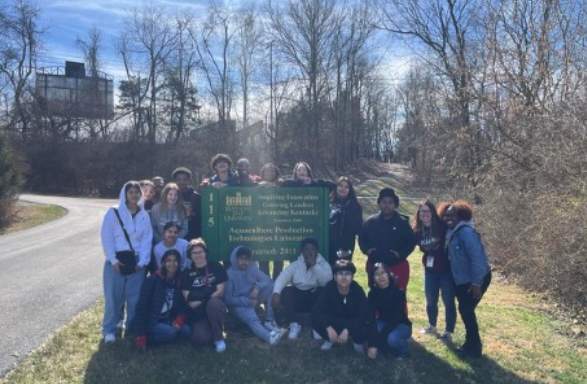
On February 29, 2024, Seventeen bright students from Mr. Eli Parham's Agriculture class explored the incredible world of aquaculture. During their tour Mr. Parham's teaching philosophy emphasizes hands-on and project-based learning, creating an environment where students can thrive and gain
practical skills.
Tates Creek Middle School students have already delved into various agricultural disciplines, such as hydroponics, plant science, food science, and seed-to-plant experiences. Their enthusiasm for learning was evident as they soaked up knowledge during their visit to the Aquaculture Research
Center.
Exciting news! Tates Creek Middle School is currently in the planning stages of constructing an outdoor classroom/greenhouse, and they've expressed their interest in partnering with Kentucky State University for this endeavor. This collaborative effort holds immense potential for further nurturing the passion for agriculture among these young minds.

During the tour, our team had an absolute blast interacting with the students, who not only asked wonderful questions but also got a little wet while feeding the hungry tilapia. Their feedback through surveys confirmed their enthusiasm for the research projects they discovered, including aquaponics and the intriguing Olive Flounder.
KSU Aquaculture Extension and Research Associate, Chelsea Walling is thrilled to continue working closely with Mr. Parham and his dedicated students, fostering a fruitful collaboration in the field of agriculture. Together, we can cultivate knowledge, inspire innovation, and make a lasting impact on the future of aquaculture!
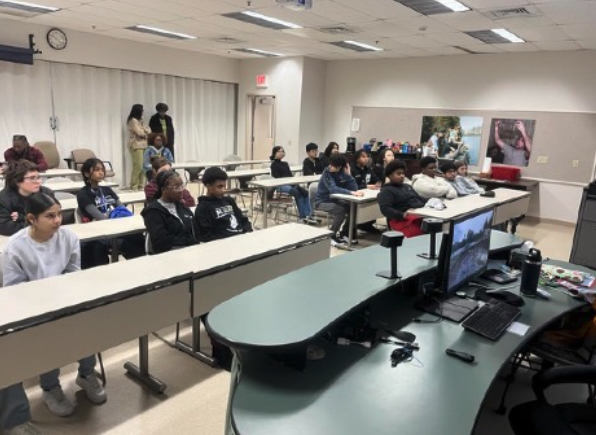
___________________________________________________________________
"Expanding Horizons: Flounder Finds a Home at Kentucky State University"
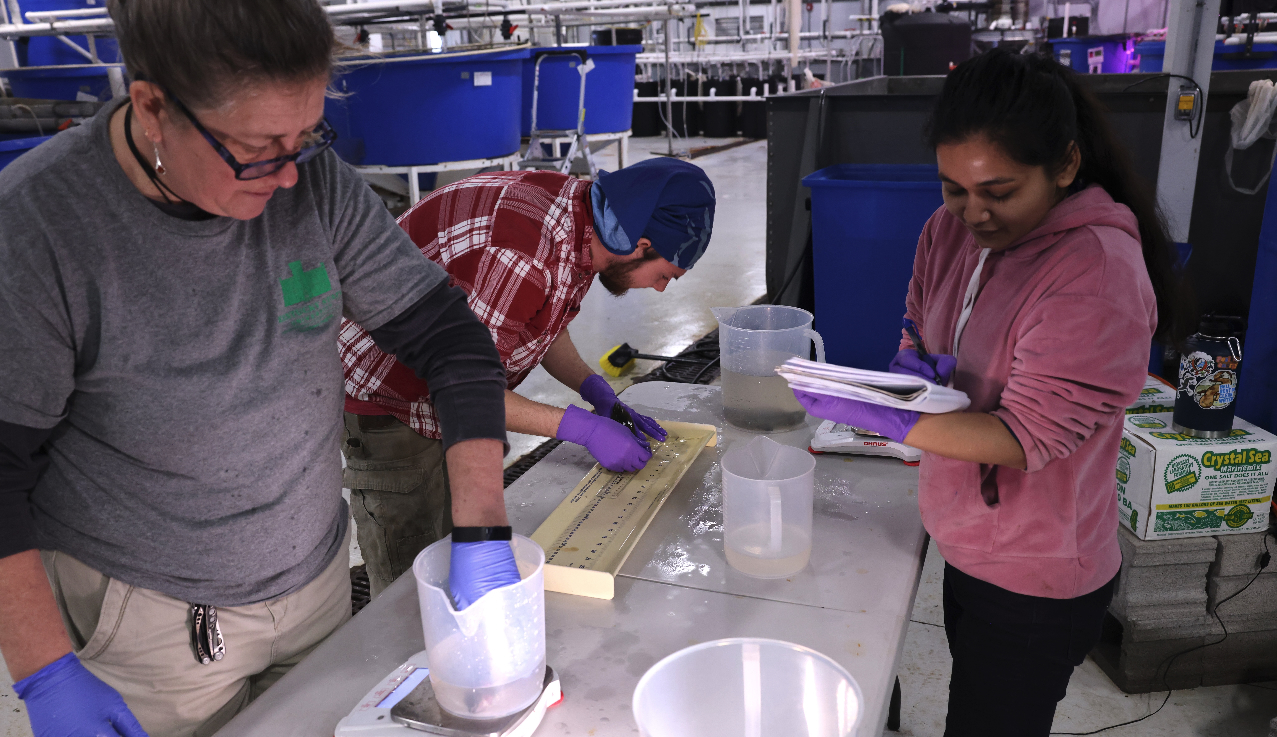
Kentucky State University’s Aquaculture Research Center is embarking on an exciting venture by introducing a new saltwater species of fish, Flounder, into their aquaculture research efforts. There are several species of flounder that are commonly raised in aquaculture. Some of the main species include Summer Flounder (Paralichthys dentatus), Winter Flounder (Pseudopleuronectes americanus), Southern Flounder (Paralichthys lethostigma), and Olive Flounder (Paralichthys olivaceus). KSU will be conducting research on the Olive Flounder.
The Olive Flounder is a highly prized species in aquaculture, particularly in East Asia. It is known for its delicious taste and firm, white flesh. Olive flounder is commercially cultivated in countries like Japan and South Korea and holds significant economic value in the seafood market. Over the past months, the dedicated team led by Ray and graduate student Sagun Chhetri have been diligently working to nurture and grow flounder, aiming to reach a size of 30 grams or more before transferring them to a state-of-the-art Recirculating Aquaculture System (RAS). This elaborate RAS will provide an optimal environment for the flounder to thrive and be studied extensively. The team's efforts and expertise in fish cultivation will culminate in the commencement of the first flounder research study, which is projected to kick off in late February.
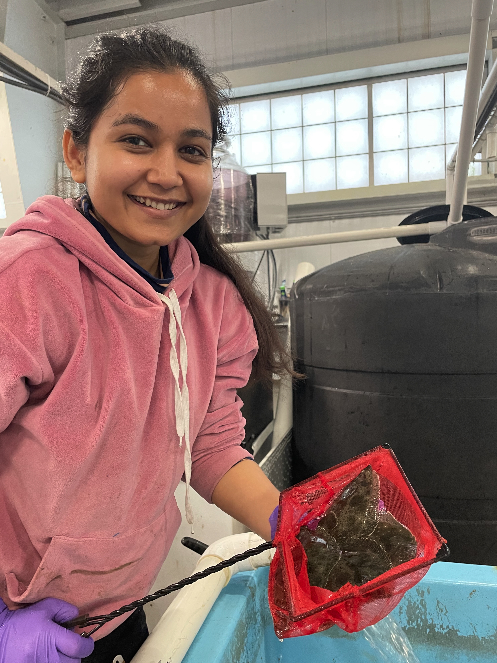
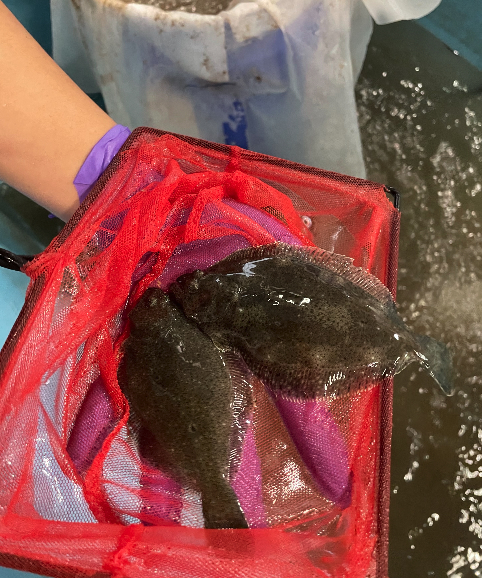
This groundbreaking initiative demonstrates KSU's commitment to pushing the boundaries of aquaculture research. By venturing into the cultivation and research of flounder, a valuable saltwater species, the university aims to contribute valuable insights to the field of aquaculture that can drive innovation and sustainability.
Photos by Charles Weibel
___________________________________________________________________
Third Thursday Thing: Aquaculture
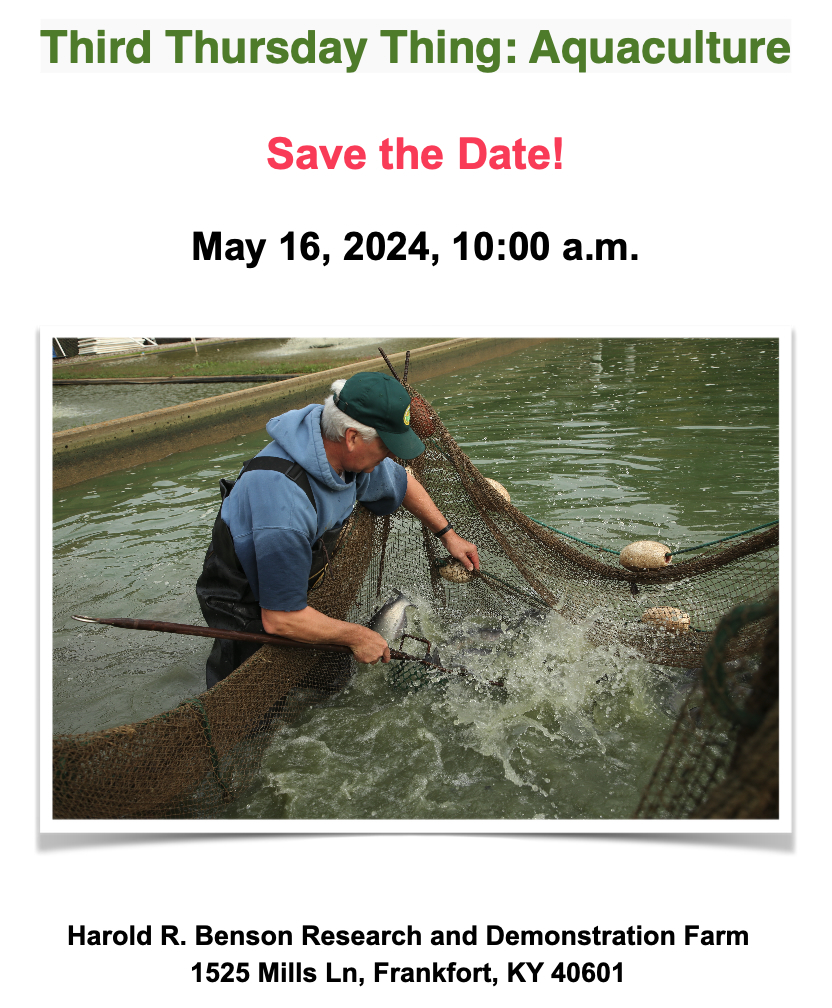
___________________________________________________________________
Faith Ohwofasa Harvested Her Largemouth Bass Research Project
IMPACT OF LOW WATER TEMPERATURE ON GROWTH, FEED
CONSUMPTION, AND FEED EFFICIENCY OF JUVENILE
LARGEMOUTH BASS Micropterus nigricans
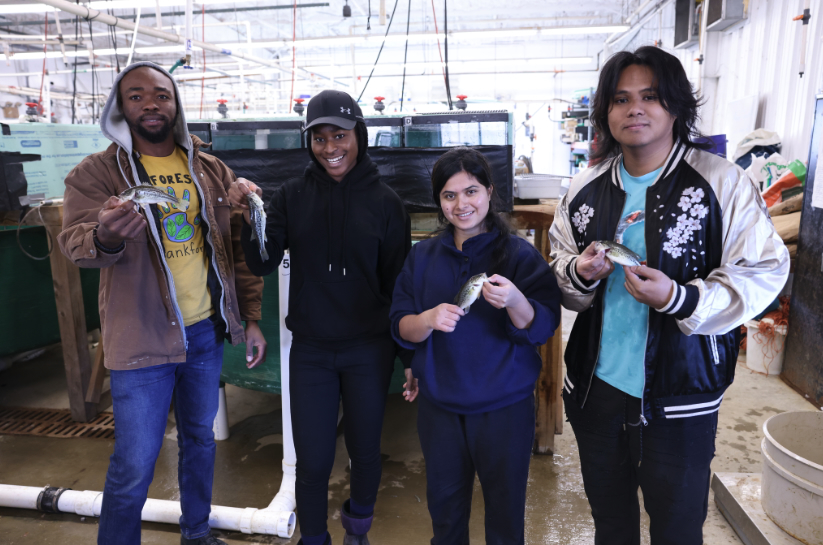
Faith Ohwofasa harvested her Largemouth Bass (LMB) research project during the holiday break. Growth of LMB as a food fish in Kentucky is constrained by a modest growing season. Her study examines growth, feed consumption, and feed efficiency of LMB at temperatures occurring in the spring or fall in temperate regions. Data generated will be instrumental in developing a practical feeding protocol for Largemouth Bass to
take advantage of growth potential throughout the year. Miss Ohwofasa’s study was conducted over a 9-week period at the Kentucky State University’s Aquaculture Research Center. Seven individual recirculating systems with each system composed of four replicate aquarium tanks were randomly assigned a temperature treatment (9, 12, 15, 18, 21, 24, and 27?).
Prior to stocking the experiment, individual (LMB) were injected with a Passive Integrated Transponder (PIT tag). Each tank was stocked with ten feed-trained juvenile LMB (56.2 ± 0.8 g) and fed once daily by hand to apparent satiation with slow-sinking 6.5 mm pellet of commercial trout feed at (45% protein, 20% fat). Water quality was monitored to maintain conditions suitable for growth. The weight, length, and tag number for each fish was recorded at the end of the research project.
Significant differences will be determined with a One-Way ANOVA, and the relationships described with a regression analysis. The ongoing analysis of weekly feed consumption measurement reveals an excellent fit between feed intake and water temperature. Full results from the study will be presented at a later date.
Photo by Charles Weibel
___________________________________________________________________
Ashton Schardt Completes His Mussel Nutrition Research Project
